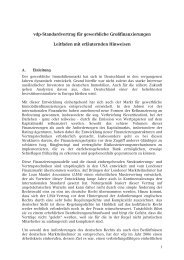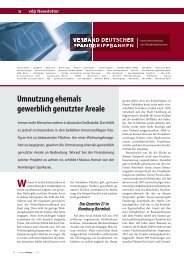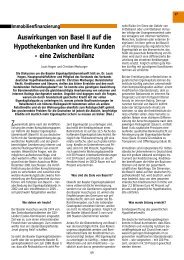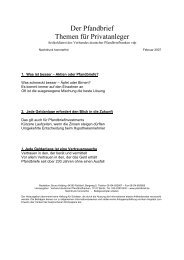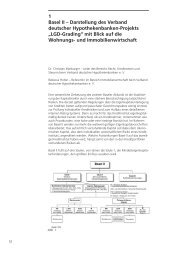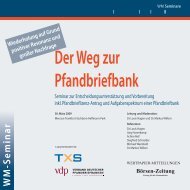The Pfandbrief 2011 | 2012
The Pfandbrief 2011 | 2012
The Pfandbrief 2011 | 2012
Create successful ePaper yourself
Turn your PDF publications into a flip-book with our unique Google optimized e-Paper software.
<strong>The</strong> <strong>The</strong> significance of common equity Tier 1 capital will be enhanced by another element of<br />
Basel III: under current regulations, common equity Tier 1 capital must make up 50% of total<br />
core capital, which in turn must be at least as high as the supplementary capital. In terms of<br />
credit risk, this means that currently the minimum ratio is 2% of risk-weighted assets for common<br />
equity Tier 1 capital and 4% for total core capital. While the regulatory minimum capital<br />
requirement to back counterparty default risks under Basel III is still 8% of the risk-weighted<br />
assets, the new rules require at least 4.5% of the risk-weighted assets to be backed with common<br />
equity Tier 1 capital and at least 6% with Tier 1 capital. <strong>The</strong> substantial tightening of<br />
Tier 1 capital ratio requirements will be phased in gradually, from the beginning of 2013 to the<br />
beginning of 2015.<br />
Introduction of additional capital buffers<br />
In future, the regulatory minimum capital requirement will be supplemented by the introduction<br />
of two new regulatory capital buffers, primarily designed to reduce the procyclical effects<br />
of the current Basel capital regime, which proved to be problematic during the financial crisis.<br />
On the one hand, banks will be required to build up a capital reserve, the so-called capital<br />
conservation buffer, above and beyond the regulatory minimum capital requirement during<br />
good times to absorb losses during bad times without violating the regulatory minimum capital<br />
requirements. If they are in danger of such a violation, banks must reduce lending and/<br />
or undertake emergency sales of assets; this “procyclicality” can further exacerbate the crisis<br />
situation. <strong>The</strong> capital conservation buffer must be comprised exclusively of common equity<br />
Tier 1 capital and will gradually be increased to 2.5% of risk-weighted assets between January<br />
2016 and January 2019. If the capital contribution buffer falls below 2.5%, the bank will<br />
be subject to distribution constraints; the more the reserved capital buffer deviates from 2.5%,<br />
the greater the constraints.<br />
Unlike the capital conservation buffer, affected banks will not be required to maintain the<br />
proposed additional countercyclical capital buffer on a permanent basis, but rather only during<br />
periods of excessive aggregate credit growth. This is designed by regulators to intentionally<br />
dampen credit growth and to build up additional capital reserves for the downturns that often<br />
follow cyclical booms. Identification of excessive credit growth and the determination of the<br />
exact amount of the countercyclical capital buffer to be held will be left to national governments.<br />
<strong>The</strong> Basel rules propose a maximum buffer of 2.5% of risk-weighted assets. Banks with<br />
international operations should use the weighted average of the national requirements in the<br />
individual countries where its credit exposures are domiciled as their countercyclical capital<br />
buffer. <strong>The</strong> countercyclical capital buffer must also consist exclusively of common equity Tier 1<br />
capital. If the required level is not held, distribution constraints shall apply.<br />
31<br />
Higher capital charges for certain risk positions<br />
While the minimum capital requirement under the Basel III regulations described above<br />
remains at 8% of risk-weighted assets (with the exception of the two new capital buffers to be<br />
introduced) and will “only” induce a shift towards higher-quality capital components, the rules<br />
also include requirements that will entail increases in the capital charges for risk-weighted<br />
assets relative to the status quo for certain categories of risk positions.




